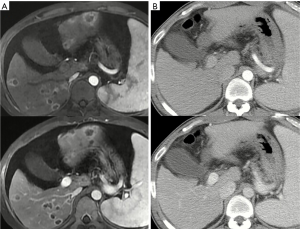
Hepatic inflammatory pseudotumor in a cirrhotic patient
A 40-year-old male with liver cirrhosis was admitted to our department due to recurrent haematemesis and melena for 7 days. He had a 10-year history of hepatitis B virus infection. Alcohol abuse was denied. During his hospitalization, except for blood transfusion, he received intravenous infusion of somatostatin and endoscopic variceal ligation and glue injection for treatment of variceal bleeding. Contrast-enhanced magnetic resonance imaging showed multiple lesions in the liver (Panel A). Tumor markers were within the normal range (alfa-feto protein was 1.35 IU/mL, alfa-feto protein L3 was 0.01 ng/mL, carcinoembryonic antigen was 3.38 ng/mL, carbohydrate antigen 199 was 21.11 U/mL). Liver biopsy was refused. No anti-cancer therapy was initiated. Three months later, endoscopic glue injection was prophylactically performed. Contrast-enhanced computed tomography scans were repeated showing a complete disappearance of hepatic lesions (Panel B). Hepatic inflammatory pseudotumor was considered. He had been followed for 27 months. Now, he is stable without any complaints.
Hepatic inflammatory pseudotumor is a rare benign liver disease, which is characterized as spontaneous resolution of liver lesions without any intervention (1). In the present case with a previous history of hepatitis B virus related liver cirrhosis, multiple liver lesions are readily misdiagnosed as liver malignancy. It is very important for such a case to conduct a short-term follow-up to evaluate whether the liver lesions will spontaneously disappear.
Acknowledgements
Funding: None.
Footnote
Provenance and Peer Review: This article was commissioned by the editorial office, AME Medical Journal for the cloumn “Images in Clinical Medicine”. The article has undergone external peer review.
Conflicts of Interest: The authors have completed the ICMJE uniform disclosure form (available at http://dx.doi.org/10.21037/amj.2018.03.10). The column “Images in Clinical Medicine” was commissioned by the editorial office without any funding or sponsorship. Dr. Qi serves as an Editor-in-Chief of AME Medical Journal. The authors have no other conflicts of interest to declare.
Ethical Statement: The authors are accountable for all aspects of the work in ensuring that questions related to the accuracy or integrity of any part of the work are appropriately investigated and resolved.
Open Access Statement: This is an Open Access article distributed in accordance with the Creative Commons Attribution-NonCommercial-NoDerivs 4.0 International License (CC BY-NC-ND 4.0), which permits the non-commercial replication and distribution of the article with the strict proviso that no changes or edits are made and the original work is properly cited (including links to both the formal publication through the relevant DOI and the license). See: https://creativecommons.org/licenses/by-nc-nd/4.0/.
References
- Aguirre-Garcia J. Inflammatory pseudotumor of the liver. Ann Hepatol 2004;3:34. [PubMed]
Cite this article as: Qi X, Guo X, Li H, Liu X. Hepatic inflammatory pseudotumor in a cirrhotic patient. AME Med J 2018;3:44.


